#meta liberation army
Text
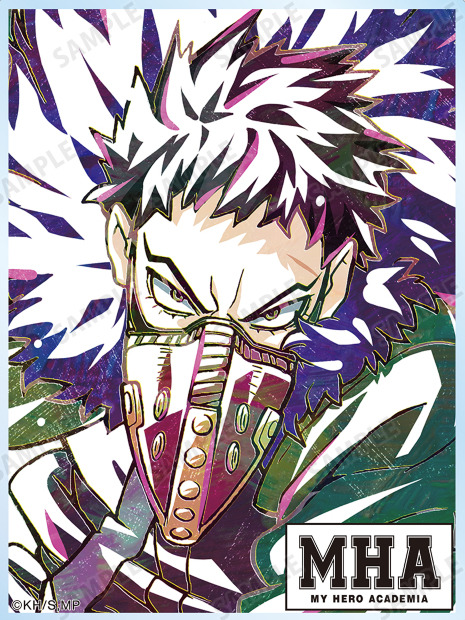
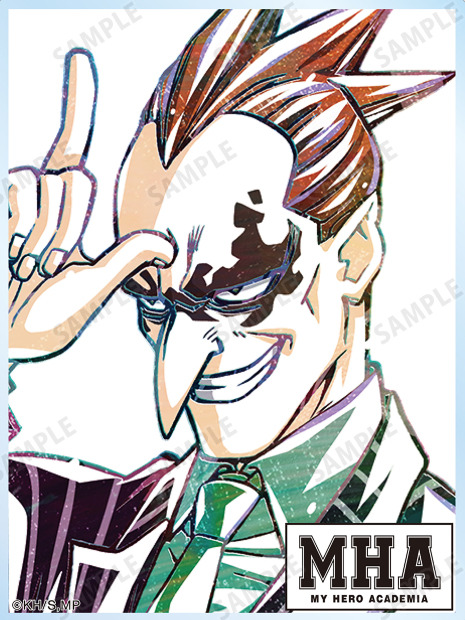

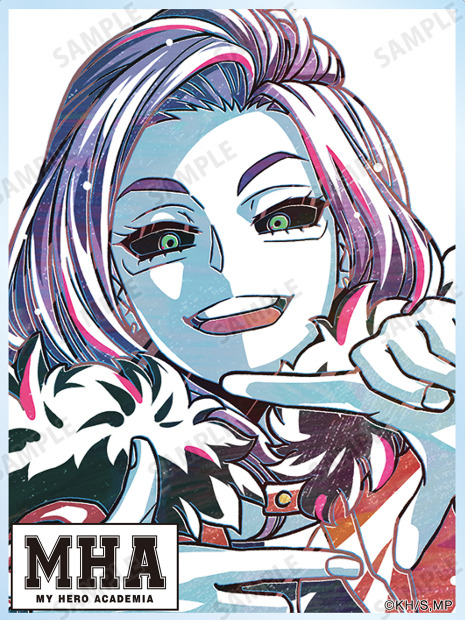
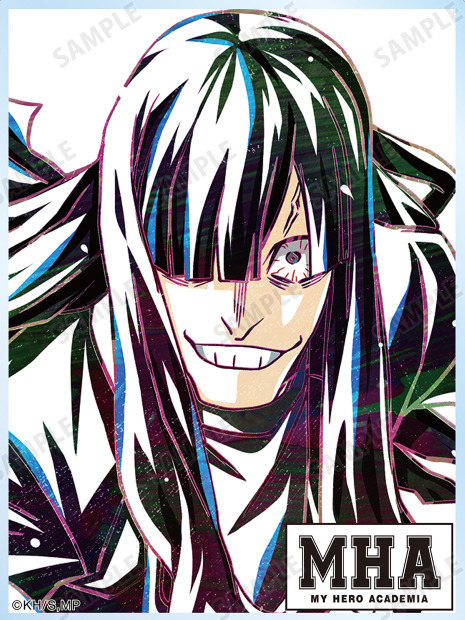

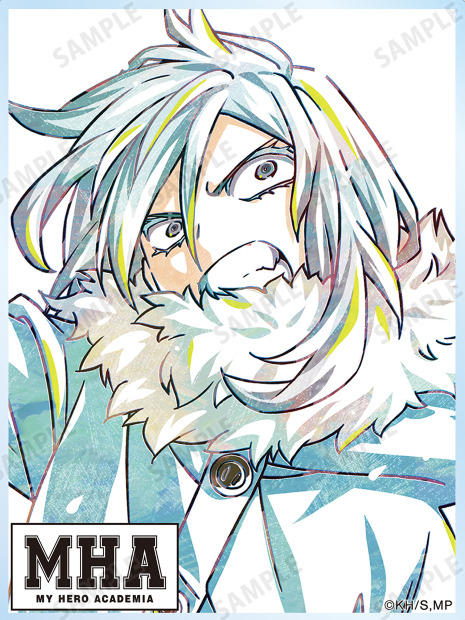
Overhaul + Meta Liberation Army - Acrylic Trading Card designs from Ani-Art Vol. 6 (2024)
League of Villains version
#bnha#bnha official#shie hassaikai#mla#meta liberation army#overhaul#kai chisaki#redestro#trumpet#skeptic#curious#geten#plf war
156 notes
·
View notes
Text
On Heteromorphs and Heteromorphobia (Arc XV - My Villain Academia)
(Skewing away from the wiki arc titles here, because come the eff on; everyone on god's green earth calls this My Villain Academia, not "The Meta Liberation Army Arc.")
At the request of a kind asker, I'm trying something different with footnotes this time; you'll find them at the end of the relevant bullet point, rather than at the bottom of the post. I've also flagged the numbers in purple, though I left the text itself the default color. I hope people find that a little easier to handle than having to scroll all the way to the bottom, have two tabs open, or wait until the end when they've forgotten the context.
Content Warning: Mentions of the KKK, as well as anti-Korean hate crimes/speech in Japan.
The My Villain Academia Arc (Chapters 218-240)
Chapter 218:
Tsuyu’s weakness to cold is noted in-canon, rather than in a volume extra profile.
All of the people featured specifically in the Detnerat commercial are heteromorphs—a four-armed woman, a walrus gent, and a little gelatinous boy. Re-Destro pontificates about how people with these “newer types of bodies” struggled in the new era because they couldn’t find products that would meet their daily needs; mass production was not equipped—could never really be equipped—to handle the endless variety of body shapes and sizes that came about due to the Advent of the Extraordinary. It recollects the mall scene back in Chapter 68—or, even further back, Ojiro’s character sheet and UA’s lack of varied desks—and calls the reader to consider, once again, the sorts of special needs that those with heteromorphic bodies might have, and how difficult it can be to meet those needs.
RD says that his company’s ability to rapidly customize and produce unique goods for every customer has made them #1 in their industry (lifestyle goods). Assuming there’s at least some truth to the commercial shpiel—and the newscaster does at least call Detnerat “a big player”—it suggests that plenty of other companies are not so good at the rapid+customizable combination. Of course, not all companies are trying to be all things to all people, but specialization costs money—as do speed and customization, really, and note that nowhere in the commercial is there a talking point about affordability! So mainly what the commercial leaves me wondering is what degree of inconvenience is still felt by heteromorphs, especially those who are somewhat cash-strapped.
That strikes me as a particular hazard when it comes to child bullying. Of course, Japanese schools have uniforms, but I wonder how available tailoring and alterations are for students with particular needs? Is there a provided budget for that sort of thing? Financial aid? How much did Ojiro’s parents have to pay for him to have a full set of uniform pants with a hole for his tail in them? How about Shouji getting all his uniform tops made sleeveless? What arrangements had to be made for Shouto’s gym uniform to be fire retardant?
Even setting uniforms aside, there are also their social lives outside of school to consider. Kids will absolutely notice when one of their number wears the same clothes all the time, or home-made clothes instead of name brand, or with obvious patchwork and repair. As in real life, it’s at the intersections of more than one type of disadvantage—in this case, a heteromorphic body combined with a low-income family—that problems become more likely.
Here in 218, almost fifty chapters after the first mention of them, we finally get the proper introduction and explanation of the Meta Liberation Army. Of course, they aren’t heteromorph-specific—the closest any of the named commander-types in RD’s inner circle get is Curious, with her bright blue skin and black sclera,[1] though certainly Re-Destro himself has drifted somewhat away from baseline compared to his ancestor. Regardless, their foundational belief is the deregulation of quirks, stemming from a time when any deviation from the norm made meta-humans targets. The compromise society reached—that quirks require a license to use—is restricting enough on those whose abilities are found with a baseline body, but, as I’ve brought up before, it makes life even more potentially fraught for heteromorphs. That kind of thing is basically a pre-written excuse for heroes or police to stop and harass a heteromorph they don’t like the look of! And while the evidence of that kind of bias has been pretty circumstantial thus far, it’s about to get way, way less so.
[1] Wacky hair colors being somewhat de rigueur in anime, we’ll give her a pass on the purple hair.
Chapter 220:
Here we finally hit the major leagues: the Creature Rejection Clan, or CRC. The Japanese is igyou haiseki shugi shuudan, with igyou and shuudan being pretty straightforward—igyou is, of course, “heteromorph,” and shuudan is any sort of organized or self-identifying group of people, anything from a family unit to a business organization, even all the way up to a nation. Haiseki shugi is the important bit, with shugi meaning “doctrine; principle” and haiseki meaning “rejection; expulsion; boycott; ostracism.” Thus, “group whose doctrine is the rejection of heteromorphs.”[2]
Note that, in the Japanese, the word in the group’s name is heteromorph; they didn’t pick something more insulting or derogatory. They didn’t really need to, since igyou is, as discussed back in the introduction to this piece, plenty derogatory all on its own. So Caleb Cook went with a translation of igyou that would better get that derisiveness-in-the-context-of-a-hate-group across than his choice way back in Chapter 14. Creature Rejection Clan is a fairly localized translation, but Cook was pretty frank in his Twitter thread on the chapter that he was thinking about the KKK when he made the decision.
And it’s not an unwarranted comparison! Of course, I wouldn’t think to presume Horikoshi’s that up on the history of racism in the U.S., but combine the cod-religious trappings and the full robes and hoods with an explicit textual description of hate crimes, and it’s an extremely easy parallel to draw.
[2] The Japanese also gives the abbreviation of CRC, with the databook eventually coming out and revealing that it really stands for the name they’ve chosen for themselves in English, the Curious Rejection Committee.
That established, it’s notable that Spinner, in describing them, says that they commit hate crimes against “people with heteromorphic quirks”—a nearly word-for-word translation of the Japanese igyou-gata no ningen. This leaves aside the idea I’ve spent so much time talking about, that heteromorph discrimination is aimed broadly at those with heteromorphic bodies, and not only those with the more narrowly defined heteromorphic quirks. Shortly, however, I’ll cover some evidence that Spinner is over-generalizing, or just misinformed.
In the meantime, take note of a few things the CRC guys[3] actually say here, starting with the fact that they call Spinner a lizard. Instantly, a word that was previously a snippy and dismissive little shrug in Dabi’s mouth takes on the weight and ugliness of a slur.
Further, they call the League of Villains “sins against nature”—or, in a more literal translation, “impure criminals.” I provide the more literal translation there because it’s more specific. My immediate question of the English translation would be whether the CRC judge the League as being sins against nature simply because of their criminality, or because of their association with Spinner, but the Japanese makes clear that there are two separate labels being flung there: the League are both criminals and impure.
This idea of impurity brings in a religious dimension to heteromorphobia, a dimension heightened by the line (dropped by the English translation) in which the CRC accuses the League of invading a sanctuary—in Shinto, shrines have to be kept pure. The CRC calling their hideout a sanctuary, with the added context of, “They have a lizard with them. How disgusting,” thus makes it pretty clear that the impurity is about Spinner’s presence, not just the League’s assorted crimes. This spiritualistic justification for bigotry will later be made even more explicit in Shouji’s flashbacks.
[3] With skull masks right there on their hoods! A real, “Are we the baddies?” moment, but given some of the other things we get on them later, it's possible the skulls are meant to contrast what e.g. Spinner or Koda’s skulls might look like: baseline human versus animalistic or “misshapen.” Credit to @codenamesazanka for connecting the dots on that!
Spinner also gives us here the line that I covered back in the terminology section at the beginning:
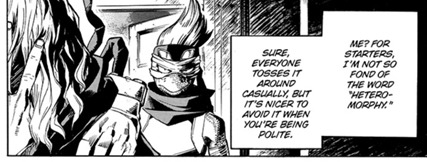
We’ll go with the official version this time.
So here we have the observation that the word absolutely everyone uses, the word that, as far as we know, academically defines an entire category of quirks, is an unpleasant, even rude word. But what is the alternative? We’re never given one. Indeed, Spinner doesn’t suggest one; he says that the nice thing to do is “avoid” the word instead. In other words, talk around it. See again what I said at the start about all the difficulties baked into that prospect.
Later, we get the first drops of Spinner’s backstory, and hit again on the “lizard” thing, with the note that Spinner’s backwater, stuck-in-the-last-century hometown called him “the lizard freak.” He grew up with it, grew accustomed to it, thought there was nothing he could do to change it—he might even have internalized it somewhat, though clearly by the time Chapter 160 rolled around he was ornery enough about it to complain.
It's perhaps also notable that Spinner knows who the CRC are. Though we’ll later find out that their numbers have hugely diminished, he not only recognizes them, he’s not even surprised to see them—unlike many, Spinner knows the CRC never truly went away. (Compare his lack of reaction to, for example, Shouji's unsuspecting classmates, who will later be shocked, just shocked, that this kind of ugliness still exists in their country.)
So just to state the obvious here, yes, the presence of active hate groups does irrevocably shift the lens on everything we’ve seen up to this point. You can’t say calling a heteromorph an animal is harmless, a little insensitive at worst, maybe even meant as a cute nickname, when that same language is used by openly violent bigots.
The volume version gives us, at the end of the chapter, further notes on the CRC. It’s full of relevant tidbits, so I’ll provide the text in its entirety:
Once superpowered society grew more stable and less chaotic, this group emerged, based around a lack of acceptance for those with body-altering quirks. They started out with demonstrations and protests but eventually started committing violent hate crimes. Most felt this was taking things too far, so the group saw a sharp decline in membership and a scattering of factions. These days, one faction might only reject people with animal properties, while another focuses its hate on people with irregular heads. These two, among others, have very few members left. The faction that Tomura and the villains attacked was one that stood by the original group's fundamental tenets.
So what is there to gather from this? Let’s break it down a point at a time.
“Once superpowered society grew more stable (...)”
If you’ve ever lived through a time of increasing acceptance for a marginalized group, particularly if that acceptance involves measures for legal protections being passed, you’ll recognize what this is. Just to pick a few U.S. examples, the KKK didn’t exist until after the Civil War;[4] proactive federal bans on same-sex marriages didn’t start getting passed/proposed until individual U.S. states started legalizing them and civil unions. When opposition to something is the norm, said opposition often doesn’t start organizing until they see that status quo being threatened; they weren’t organized before because they never imagined they’d need to be! That’s what we see with the CRC: they didn’t formally declare themselves until it started looking like quirks—and especially non-baseline quirks—were going to find legal acceptance.
[4] Literally. The last day of the war was May 26, 1865; the date the first Klan was founded was December 24 of the same year. Easily the most vile thing I learned in the process of writing this piece.
“(…) based around a lack of acceptance for those with body-altering quirks.”
This is what I was referring to when I said Spinner's characterization of the CRC might be a little bit off: the CRC wasn’t founded because of a hatred for specifically heteromorphic quirks; they were founded because of a hatred for different bodies, a descriptor that could also apply to those with transformation-style quirks! Those, too, are quirks that alter bodies, after all; it’s just possible for people to turn them off, which is not the case for those with heteromorphic quirks. So Spinner was not quite on the mark before.
Further, note that the phrase “body-altering quirks” is used here—a phrase that’s similar in meaning and much less othering than igyou. It doesn’t fully cover everything I use “heteromorphic” and “non-baseline” to cover, in that it’s still murky in situations like e.g. Cementoss’s, where his emitter quirk is entirely independent of his oddly shaped head, but it’s still a useful term! Except for the small complication of where it isn’t found: anywhere in the actual story. The fact that Horikoshi uses it in an author’s note, but it comes up nowhere in BNHA proper, puts it in an unclear place as far as in-universe alternatives go. Has it just not come up because Horikoshi hasn’t thought to include it? Or has it not come up because it’s not a phrase people in-universe use?
“They started out with demonstrations and protests but eventually started committing violent hate crimes. Most felt this was taking things too far, so the group saw a sharp decline in membership and a scattering of factions.”
Confirmation here of what Spinner said about the CRC and hate crimes, but note what this doesn’t say: that the CRC was outlawed. There are, I suspect, a couple of factors influencing that.
o Firstly, while Japan has legal methods to restrict undesirable organizations,[5] making it difficult for them to raise funds or engage in publicity, the country doesn’t actually de facto criminalize membership in such organizations. That distinction is part of the legacy of violent crackdowns on labor groups and protest movements in the first half of the 20th century; people tend to get very loud about anything that whiffs of the government trying to give itself the power to get that heavy-handed again.
Assuming that the laws haven’t changed overmuch in HeroAca!Japan, then, I wouldn’t expect membership in the CRC to have been criminalized outright, but the volume extra doesn’t mention any kind of legal repercussions at all. That, I think, may go more to my next point.
[5] The relevant laws are aimed mostly at terroristic groups or organized crime.
o Secondly, another thing Japan has very, very little of is hate crime legislation. From my research, there are only two laws of any note: a federal law passed in 2016 and widely regarded as toothless thanks to it lacking any criminal provisions targeting offenders,[6] as well as a local ordinance passed in Kawasaki in 2019 that went as far as mandating fines against repeat offenders, among other measures.[7]
[6] It required the government to start “implementing measures” to eliminate such speech/behaviors, as well as to “respond to requests for consultation” from victims, but did not directly mandate consequences for offenders.
[7] I suspect from some of what I read that Osaka has picked up a similar ordinance, but I didn’t find anything detailing it specifically. Osaka and Kawasaki are home to the largest and second-largest population of Koreans living in Japan.
One major thing neither of these measures did, though—and something activists have been pressing for—is to establish standards for considering discriminatory motivations when issuing sentences against those who have committed violent crimes. To pick an example that made the news last year, a man committed arson out of openly admitted hatred for the Koreans he targeted, but nowhere in the trial or discussion of his sentence did the prosecution ever bring up discrimination.[8]
[8] https://mainichi.jp/english/articles/20220829/p2a/00m/0na/015000c
Also, it’s worth noting that both of these measures were aimed at ethnic discrimination—speech and behavior targeting people living in Japan while being themselves, or being children of, people of non-Japanese ethnicities. They did not address discrimination based on e.g. religion or sexuality.
Folding both of those points together, the image we have of the CRC is of a violent hate group whose existence is regarded as perhaps distasteful and extremist, but not actually illegal. Even what few laws Japan has now wouldn’t have applied to anti-heteromorph discrimination, because, while they may look wildly different from a prototypical Japanese person, heteromorphs still are Japanese, and therefore not protected by a law based solely around ethnic discrimination.
Incidentally, the ordinance in Kawasaki laid out a number of specific examples of the kind of behavior it was looking to address, and one of those examples was likening victims to something other than human. I know why that was included in the context of anti-Korean sentiments,[9] but it certainly does shade e.g. Dabi calling Spinner a lizard more harshly to know that there’s legal precedent for categorizing such dehumanizing language as hate speech.
[9] An extremely common form of anti-Korean hate speech in Japan is to refer/allude to Koreans as cockroaches.
“These days, one faction might only reject people with animal properties, while another focuses its hate on people with irregular heads.”
This is a good echo of the sort of factionalization you see in organized religion, wherein the minutiae of tenets that seem similar to an outside eye are the topic of vicious, vehement inter-group debate. More to the point, however, it provides an excellent illustration of the senselessness of bigotry. They can’t even keep their own discriminatory dogma straight!
Probably the second most common complaint about the story’s use of heteromorphobia—after calling it retconned-in bullshit that didn’t exist until Chapter 220—is that it’s illogical, that it makes no sense to judge people because they look a little different in a world where everyone is now a little different from the way we see the world.
And I wonder if the people who say that are listening to what they’re saying. “Illogical bias that has no foundation in reality is unrealistic?” What do these people think bigotry is? Racism, sexism, xenophobia, ableism, religious discrimination, all the many different shades of queerphobia: all of these are built on foundations of fear and hate for people who are fundamentally still as human as anyone else, yet they all exist, and have existed, and will go on existing for quite some many years still. Because irrational hatreds are, by definition, irrational. Heteromorphic discrimination is the most realistic societal dynamic in the entire series!
That little rant aside, I also want to highlight the first group in the excerpt above—people with animal properties. Check any talk on the theme of, “So you can believe dragons but not black people in fantasy?” and you’ll run into the ways people are much more ready to suspend their disbelief for full-on fantasy than for something that, rightly or wrongly, pings them as incorrect, and it’s easy to imagine animal-associated heteromorphs running into a similar issue: it’s fine for people to just look weird, but looking like an animal, that’s bad and unnatural. A heteromorph who just looks like nothing in particular other than “non-baseline” is not evoking the baggage of animal anthropomorphization and cultural animal symbolism that someone who looks like a bird, a lizard, a dog, an orca, etc. is.
Chapter 223:
Shigaraki refers to Gigantomachia as a gorilla. It’s debatable how much this is of a piece with Dabi calling Spinner “Lizard”—Machia’s only actual animal quirk is Mole, not anything simian, nor is Machia particularly ape-like in anything other than his large size—but it does stand out to me that Spinner, who we know to have strong opinions about animal epithets, just refers to Machia by name or as “the big guy.”
Chapter 224:
Mr. Compress calls Machia “our pet gorilla”; see note above.
Chapter 226:
Curious introduces the idea of quirk counselling, telling us that its goal is to align people to a unified understanding of how the world and society work, but that it’s flawed in that it winds up emphasizing peoples’ differences instead. The advisor at the hospital raid will include quirk counseling in his litany of grievances, so I’ll discuss its possible utilization against heteromorphs more there, but for now, recall that I talked previously about how quirk-based behavioral tics might vary from person to person by comparing Hound Dog with Sansa. With that in mind, it’s not a big reach that some heteromorphs might run into similar problems with quirk counselling.
There are a good number of what appear to be heteromorphs through the Curious fight; whatever the MLA’s core views on quirk supremacy, the organization self-evidently makes ample room for heteromorphs, even if, like e.g. the red panda guy in the crowd jumping Toga inside the noodle joint, they don’t seem to have any other stand-out powers beyond the fur and fangs.
Chapter 229:
Twice notes in his flashback that something about his eyes always rubbed people the wrong way, scared them. We’ll eventually see this same thing with Tenko on the street—a totally normal-looking child, but the look on his face scares people away even more than the blood. And I can’t help but think, “If even a totally baseline person’s eyes can creep people out, how much easier—and more extreme—is that reaction for the more out-there sort of heteromorph?”
Gori makes the tiniest of cameos in Twice’s flashback, playing backup off to the side when we will, in current times, find him having worked his way up to the interrogation chair himself.
Chapter 230:
Geten brings us quirk supremacy via his understanding of the MLA’s goals. It’s hard to say how accurate this is, since the MLA leadership is inconsistent on what exactly their vision of Liberation entails. Whatever it is, it certainly doesn’t seem to dissuade the MLA’s own heteromorphs, though of course there’s a big difference between how e.g. Spinner or Ojiro versus Gang Orca or Mirko would fare in a societal quirk free-for-all. Likewise, the MLA is a cult, so one can’t discount the likelihood of double-think in its members.
Chapter 232:
Re-Destro talks about the state of the country in Destro’s infancy, a period in which metahumans suffered “constant abuse—blatant discrimination.” Merely for speaking out that her child was just like everyone else—that his special power was just a quirk—Destro’s mother was killed by an anti-meta mob. This gives us further evidence of the violence metahumans faced. Of course, in that time, the hate wasn’t distinguishing between types of quirk, but with that being said, an emitter and a transformer can still hide the truth about themselves with far more ease than heteromorphs—recall All Might’s discussion about the early days of quirks back in Chapter 59, in which the panel showing four people with quirks contained only one baseline person. It would be entirely unsurprising for an outsized number of the metahumans killed in those days to be heteromorphs.
Chapter 233:
The confrontation between Trumpet and Spinner gives us Trumpet clucking about Spinner having a weak meta-ability—Gecko lets him cling to walls, and that’s about it. It’s a striking contrast to someone like Mirko or Gang Orca, or even Tsuyu, all of whom have some combination of big power moves and a veritable fleet of sub-abilities. We can see the way Hero Society prizes powerful, flexible quirks in this. Having a strong quirk can help overcome the societal bias about heteromorphs, but if you’re stuck with a weak quirk and a weird face, you lack that metaphorical ticket out.[10]
[10] Incidentally, the fandom reflected some of that attitude as well. There was a widespread assumption that Spinner’s quirk would be really useful or situationally powerful, otherwise why would Horikoshi have hidden it for as long as he did? Then, after the reveal, there was a certain amount of complaining that Spinner was useless to the League, and why even bother with him? Sometimes, life imitates art in some very unflattering ways.
Trumpet brings up that Spinner was a recluse, “mocked and pilloried,” and we see Spinner in his hikikomori days. What we’ve gotten on Spinner up to this point suggests that the abuse he endured was mostly verbal, though one can imagine it was pretty rough when he was young enough to be the target of school bullies. There’s a certain amount of temptation to minimize that in comparison to his response: most people who are bullied or targeted by discrimination don’t grow up to become terrorists. But there was, we will eventually find, more visceral stuff going on—and parts of the country that were even worse than Spinner’s hometown.
Spinner spent most of his life trying to fit himself into the world around him; his strongest parallel in the League
in this regard is Toga, as they were the two that held themselves back, let the world define what they were and how they should act, right up until they saw something that caused them to snap.[11] Trumpet tries to do much the same to Spinner here (albeit probably less as an intentional psychological attack than Skeptic’s attempts on Twice), but Spinner, like Toga, is long past the point where he would swallow that abuse without fighting back. When you tell someone they are something long enough, they eventually start to believe it—but if you aren’t careful, they’ll start to embrace it, at which point those weaponized words change hands.
[11] Shigaraki and Dabi, by contrast, pushed back harder, trying to get the world to accept them and never accepting it when their families (and particularly their fathers) told them to stop. Twice was ejected without getting the chance to try to contort himself into a shape that fit the world, whereas Mr. Compress seems to have been raised to reject his society's accepted norms from the start.
Chapter 234:
We see an image excerpted from Quirks and Us, a children’s book published by Curious’s outfit, that exhorts the reader not to judge people by their quirks. It really, really begs the question, “If this is what’s being said in literature published to coax people towards anti-suppression radicalism, what on Earth is normal society saying?”
Regardless of that absolutely wild disparity, though, the fact that there are children’s books being published about quirk bias being wrong suggests that the world very much does have a problem with quirk bias. Indeed, that much has been shown throughout the series, not merely in terms of anti-heteromorph bias, but also the bias against “villain quirks,” as well as the widespread idea that people with weak quirks—or no quirks at all—are weaker people overall, pitiable folk who lack the power to live their fullest lives or pursue their dreams unhindered.[12]
People on more than one of these axes of discrimination will, as in real life, be more likely to experience discrimination and violence.
[12] Villains like All For One and Geten may say it more loudly, but it’s not only villains who believe it—perfectly good-hearted people like All Might and Midoriya Inko fall into that trap as well.
Chapter 237:
Nothing much to say about Shigaraki’s flashbacks save to note that, if people won’t stop to help a lost and bloodied (and baseline) child, they sure as hell won’t intervene in anti-heteromorph bullying. Recall that Kirishima was accused of sticking his nose where it didn’t belong for trying!
-----
Thanks as ever for reading along, everyone! How was the new footnote format? Should I keep that up for lengthy meta going forward?
I was kind of expecting to be able to wrap this up (the main canon, at least) in one more post, but I underestimated the amount of writing I'd be doing for the first war arc. For next time, then, I'm looking to cover the Endeavor Agency, Paranormal Liberation War, and Dark Hero Villain Hunt arcs. See you all then!
#bnha#heteromorph discrimination plot#bnha worldbuilding#bnha meta#my writing#creature rejection clan#tw racism#tw hate crime#bnha spinner#iguchi shuuichi#meta liberation army
81 notes
·
View notes
Text

Flustered 🖤
#god i love skeptic 😩#art#my art#artists on tumblr#toaitc art#fanart#mha#bnha#my hero academia#boku no hero academia#mla#meta liberation army#skeptic#tomoyasu chikazoku#gorillaz#demon days#i hope you like it 🙏
83 notes
·
View notes
Text
Okay, store has been updated and what better group of individuals to drop first than the MLA? Anyhow, as usual you can find the link HERE!
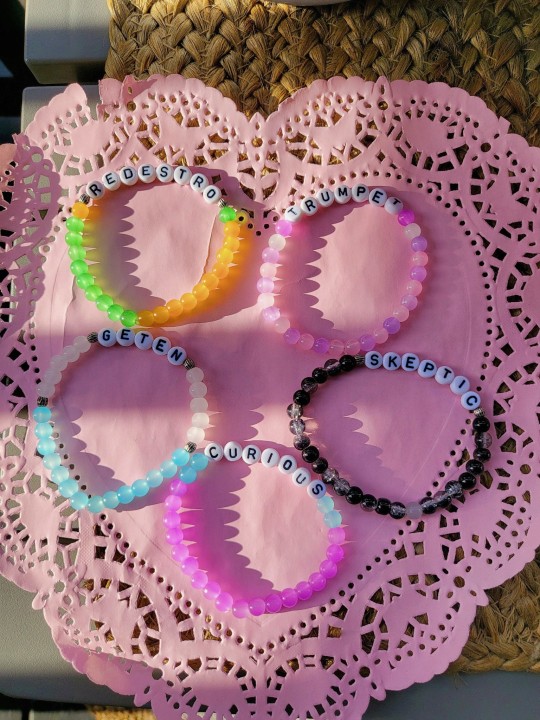
(And thank you to anyone who bought anything when I reopened. Thank you to anyone who shared/reblogged/liked my post. Thank you to anyone who looked at the site, and thanks to anyone who took a second to read the post. Any amount of interaction helps tremendously and is GREATLY appreciated😭💕)
#mun speaks#bnha#mha#boku no hero academia#my hero academia#meta liberation army#mla#redestro#rikiya yotsubashi#curious bnha#chitose kizuki#skeptic bnha#tomoyasu chikazoku#geten bnha#trumpet bnha#koku hanabata#small business#anime merch
34 notes
·
View notes
Text
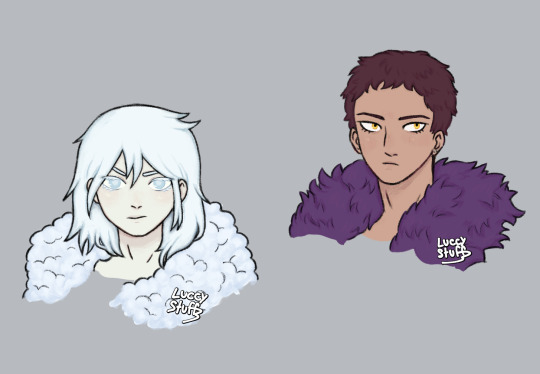
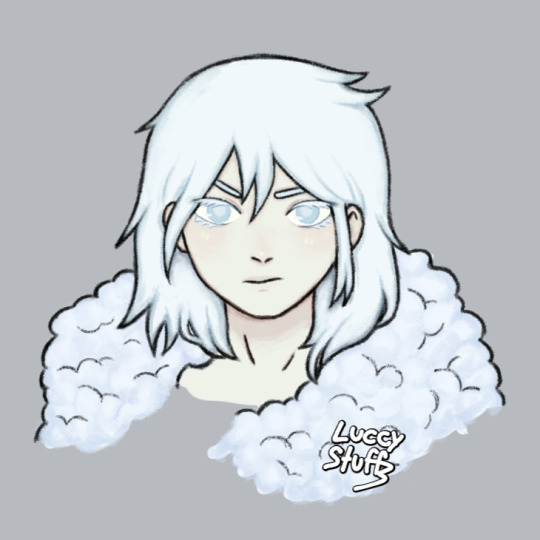

first drawing in clip studio and I tested it with these two
#(because they have fur coats#and I love their designs#I liked clip studio#I found it easier to render in it than in ibis but I don't know if it's just in my head#I <3333 geten#overhaul sucks#bnha#mha#kai chisaki#overhaul#geten#meta liberation army#myart
40 notes
·
View notes
Text

rather fashionable
#tomoyasu chikazoku#koku hanabata#mha skeptic#mha trumpet#meta liberation army#paranormal liberation front#skeptic#trumpet#my hero academia#boku no hero academia#mha#bnha#fanart#art
26 notes
·
View notes
Text
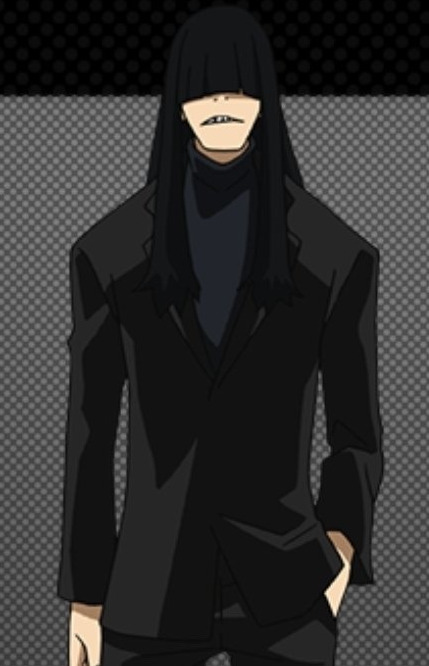
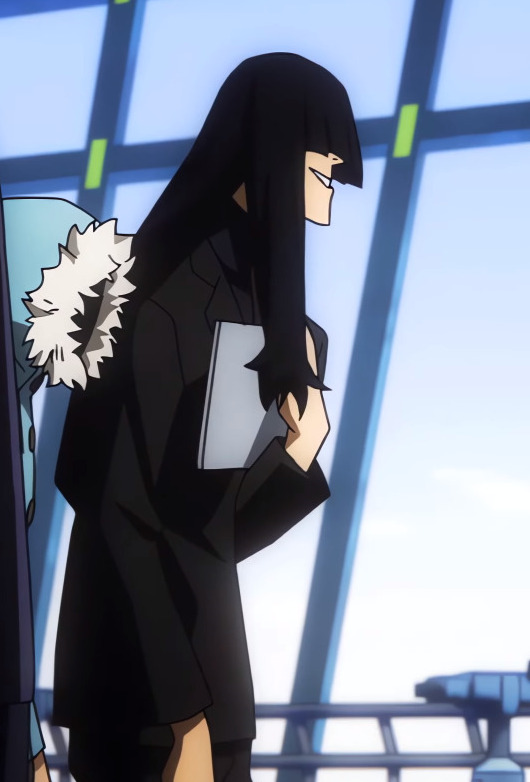
#bnha#bnhasmashorpass#smash or pass#my hero academia#villain#paranormal liberation front#meta liberation army#tomoyasu chikazoku#bnha skeptic
28 notes
·
View notes
Text
Ah yes, the dollar store villain team (affectionate)
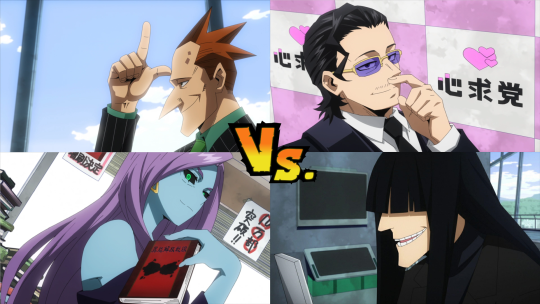
#bnha#mha#my hero academia#underrated mha poll#rikiya yotsubashi#redestro#koku hanabata#mha trumpet#chitose kizuki#mha curious#tomoyasu chikazoku#mha skeptic#meta liberation army
39 notes
·
View notes
Text
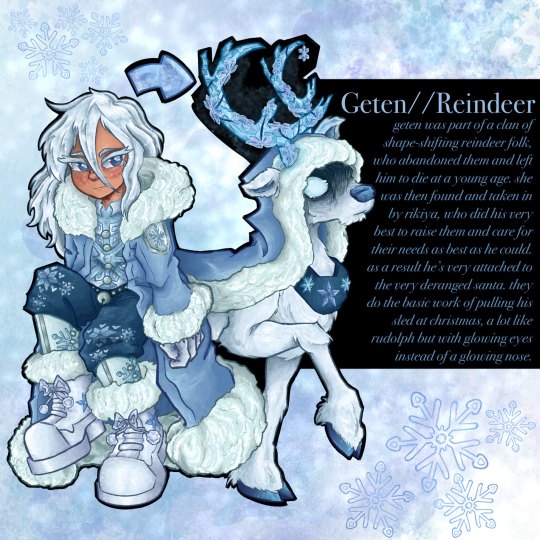

HOLY SHIT ITS GETEN!!!!!!!
GETEN
the only two people in this au i ever wanna draw again are santa rikiya and a baby version of reindeer geten.
#geten#bnha geten#apocrypha bnha#meta liberation army#geten bnha#rikiya yotsubashi#redestro#skeptic bnha#tomoyasu chikazoku#bnha villains#paranormal liberation front#bnha#my hero academia#my art#reindeer#rudolph the red nosed reindeer#santa claus#krampus#?#anime and manga#anime aesthetic#anime fanart#manga#winter#winter aesthetic#snowflakes#vintage#aesthetic#geten himura#himura
38 notes
·
View notes
Text
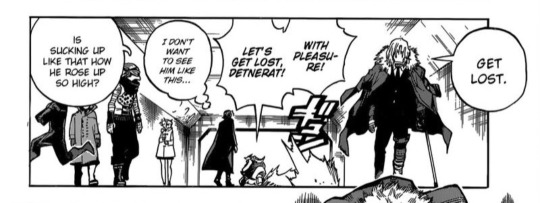
1) Tomura complete disregard of politics is one of the best parts of the Meta Liberation Army arc, 2) almost as funny as those Spinner anti-politicians comments, 3) imagine seeing your boss —who is a competent businessman with years of success and the loyalty of a small nation to support him— reduced to an absolute fanboy by this wreck of a barely adult with the power to destroy cities and the priority sense to spare an entire enemy army 'cause one of his men said he wanted suchi.
Imagine Spinner calling you out for sucking up to Tomura, the little guy Spinner literally destroyed himself for.
#bnha#mha#boku no hero academia#my hero academia#league of villains#lov#bnha spoilers#mha spoilers#spinner#shuichi iguchi#rikiya yotsubashi#redestro#shigaraki tomura#tenko Shimura#meta liberation army
98 notes
·
View notes
Text
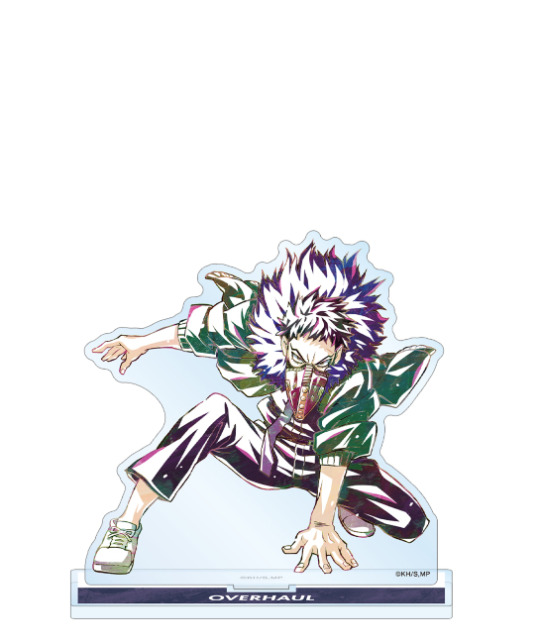
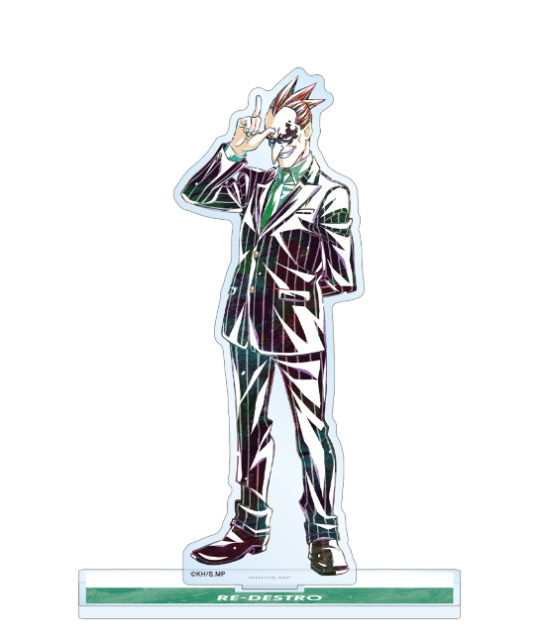

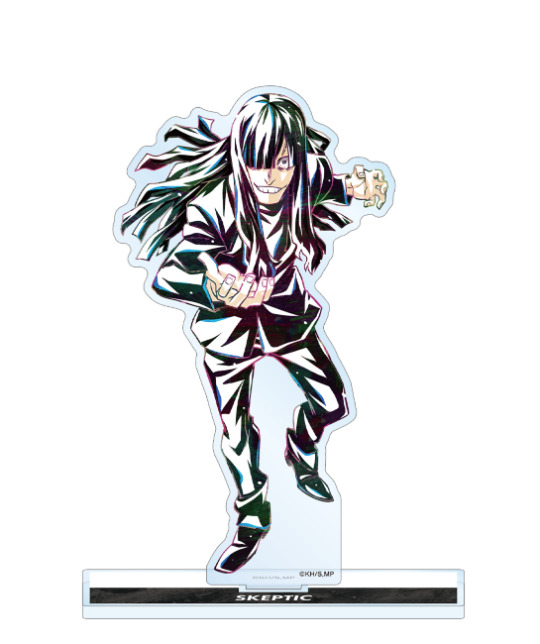



Overhaul + Meta Liberation Army - Acrylic Stands from Ani-Art Vol. 6 (2024)
League of Villains version
#bnha#bnha official#shie hassaikai#mla#meta liberation army#overhaul#kai chisaki#redestro#trumpet#skeptic#curious#geten#plf war#mva
22 notes
·
View notes
Text
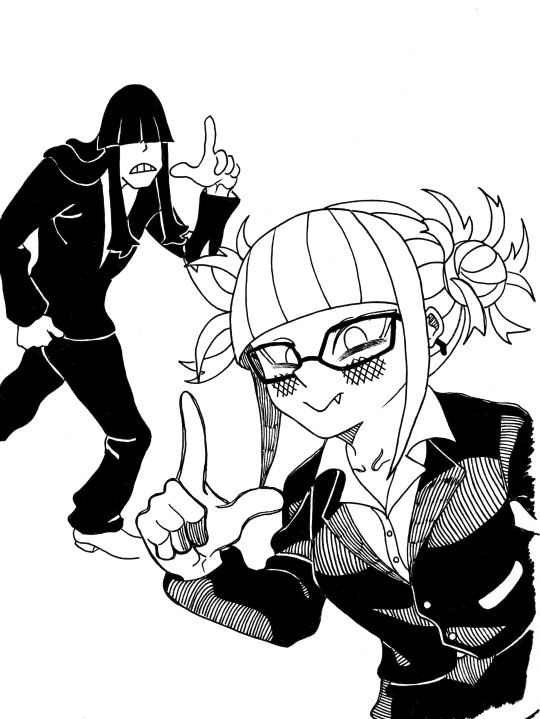
Day 29: Suit
#himiko toga#mha himiko#my hero academia#toga himiko#togavember#mha fanart#mha#togachako#bnha#bnha himiko#mha skeptic#bnha skeptic#atsuhiro sako#meta liberation army#paranormal liberation front#suit#office#office lady
59 notes
·
View notes
Text
OK, uh, I am, like, writing this crack fic right now, don't worry about it too much, and I was looking back up the Meta Liberation Army thing...
And, uuuuuuuh...
Can we talk for a QUICK SECOND about the ideology of BNHA villains?
OK, like, I'm trying to do this thing in the fic, where I position the Meta Liberation Army and Humarise from the Movies as two diametrically opposed ideologies for obvious reasons, and Humarise is easy as shit to write, it's just a Death Cult who believes in what is, in universe, a fringe conspiracy theory by a disgraced quork scientist from 50+ years ago, an hypocritical one at that since none of their high ranking members are Quirkless despite advocating for Quirkless rights.
Anyway, in my fic they just finance the Shie Hassaikai for now, hence the gang not going under, and and will come into play later, but I had the bullheaded idea to also tackle the Meta Liberation Army immediately for added drama, you know, the parallels, and holy shit...
The MLA are Ancaps.
This is, and I can't stress this enough, the most charitable way I can read them.
Their entire ideology is essential unregulated freedom. Everyone should use the quirk the way they see fit, with no permits or licences, always. Basically the dissolution of the social contract they are currently living in.
This is also the ideology of the League of Villains mind you, but there is a big difference there.
ReDestro is a rich fucking businessman.
The three top leaders of the Army? One controls the biggest telecommunication company in the country (Modern Media) the other their biggest publisher (Traditional Media), and the third is a GODDAMN POLITICIAN.
Do we know... ANYTHING about the Political Leanings of the Hearts and Minds party in canon? Like, I assume they'd be advocating for ways to ensure Meta Liberation Army doctrine to be upheld right? Which means tax cuts for their allies, lessening in quirk regulations, I guess some Token Heteromorph support?
Keep in mind the only Heteromorph among the MLA top ranks, as well as the only woman, is also conventionally attractive. Like, I can DEFINITELY see her as a great example of some weird Glass Ceiling "Got mine fuck you" situation, in the way her gender and quirk are ultimately secondary to her Social Class as a member of the rich elite.
Like, shit, the more I read about them the more I am amazed Horikoshi essentially wrote about how in the BNHA universe there is a secret society composed by the richest men in the country, infiltrated at the highest ranks of society, even among heroes or the commission, advocating for deregulation and zero oversight...
And then just... Did nothing with it.
Like, ReDestro straight up... Picks a fight with the league and then that's it, we doing villain shit now, time to suicide bomb the commission for no reason, the MLA could have EASILY fucked over Japan with a 10 year plan of gradual political shift, and NO ONE could have done anything about it cause they are just normal businessmen at that point.
"You don't arrest Lex Luthor for burning the rainforest you arrest him for using a giant robot to do it" sort of shit.
Like, imagine this shit is tackled with the gravitas it deserves, and Izuku has to come face to face with the fact hero society is corrupt and a slave to capital and he can't do jack shit from stopping a LITERAL POLITICIAN from spreading harmful rhetoric via social media and the traditional medias unless he goes rogue and starts car bombing people, that he can't even "vote with his wallet" cause Detnerat controls most of the market when it comes to support items?
Like, damn.
72 notes
·
View notes
Text
Some Vain Attempt At Giving Every Member of Class 1-A (plus one more) a 'Nemesis' Pt. 1 of 3 - Jailbreakers...and Slidn' Go.
Now this is something that's been on my mind since like, what, a year now? Back before this blog existed a comment from @stillness-in-green asked why I thought Tsu should have been Spinner's 'Nemesis' instead of Shoji...
However, due to a combination of shyness, scattered thoughts and business, not only did I pretty much hold off on giving my thoughts, I also got hit with an idea that I'm both loving...and deeply regretting!!!
"Say, instead of just doing why I think Spinner and Shoji aren't a good match-up...why not give legit everyone in Class A (and a certain someone else), a Nemesis. Because what I'm doing isn't hard enough to explain as is!"
So I did, and have practically everyone else mapped out. What you see below are basically, most of the tertiary squad of Class A get their due facing against a Villain that I feel would be roughly on par with them and still be a meaningful clash (though not as important to those that got the League/upper MLA executives).
In addition, I added pretty much how I would write their 'arcs' so to speak concerning their clashes with these Villains. Nothing full blown, but just a bit of concepts had in mind that I feel would make their last battle meaningful.
Now, concerning these pairs I did have some rules going in place (because I can't make it easy in myself, why...) First rule is that the Villains chose have to be members of the League of Villains or its alliances. For example, Paranormal Liberation Front or whatever the Hell the Final War villains are called, are game. That said, I can't use Villains from spin-off or movie material, and Nomu's aren't allowed either (the former due to just wanting to contain things to the manga as much as possible, and the latter is more for balancing reaons).
Also, on that note, concerning the likes of Dabi/Shoto, Toga/Ochaco, and Deku/Shigaraki, they aren't going to be listed since...well, they're pretty much established enemies in canon! No real need to re-state them here. Also, AFO is hard locked to All Might if you were wondering, so he's not making an appearance here either. Neither is Gigantomachia or the Advisors (except one), due to balance and just being way too easy to fill up the roster with.
So with that stated, here we go!
Slidin’ Go - Sato
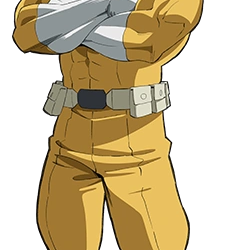

It’s speed vs power with this one, a match between the traitorous Hero who can, ideally, weave himself away from heavy blows against someone who can be stronger to take him down, but has to find a way to get that solid hit in.
Character wise, I want to imagine this being a storyline where Sato becomes insecure over his Quirk’s weaknesses and how unreliable he feels it might be. In a class where people can harness the elements, shoot intense soundwaves, and warp gravity - having a Quirk with a cognitive drawback and intense fatigue + being yet another strength Quirk would actually be a good way to explore the inner doubts of feeling redundant or unneeded.
As a foil to Sato, Slidin Go could be a Villain with heroic intentions at one point. However, Slidin Go was eventually overshadowed by speed/mobility Quirks that were functionally better (like Ingenium) and his popularity dropped to the point he became borderline poor given how low he was in the Hero rankings. S.G. joined the MLA as their man on the inside, in exchange for promoting him to rise higher in the rankings. Because, at his lowest point, all he cared about was just being able to sustain himself. The price to pay for being seen as redundant and how he sympathizes with Sato.
Assuming this takes place in a timeline where S.G. is participating in the Final War, Sato thinks outside the box to best S.G. With the last of his cognitive strength, he shatters the ground to trip SG up before taking him out in one strike. Sure, his Quirk might be ‘redundant’ in the face of others, but what matters in the moment is not caring about one’s status but doing the right thing, in spite of it. A lesson that Slidin’ Go forgot long ago...though maybe, in time, after his arrest he can regain that spark?
Kunieda - Aoyama


Now this is one that, really, already played out in the manga, but will restate it here briefly since there is an interesting dynamic here, if brief. Aoyama and Kunieda offer a unique spin on the ‘loyal ally versus the traitor’ plot. Aoyama is the Traitor, a double agent for the Villains that goes against them for the bonds he made undercover and to make up for his wrongs. In contrast, Kunieda is someone actually loyal and grateful to All For One - his liberator (heck, one of the few that seems to genuinely be loyal to AFO in the Second War) and hates Aoyama for switching sides. It’s to the point Kunieda personally wants to kill Aoyama just to keep up AFO’s streak (which, to me, gives credence to Kunieda being a former associate to AFO and not just a random Jailbreaker).
In media, I always found it interesting when the heroes are people who betrayed their former allegiance for someone else, and their rival end up being someone fanatically loyal to their old group. I think its because, if alignments were reversed, it’d be easy to portray the Traitor as being self-serving and cowardly, compared to those who remain whose loyalty to their boss who would be seen as virtuous. Given both of their personalities, with Aoyama actually struggling with cowardice and Kunieda being fiercely behind AFO, its not an unreasonable thing to consider at all.
Here? It’s pretty much saying that not only is it okay to betray someone who you work for, if they’re as toxic and awful as AFO, but the virtuous thing in this instance is to go against them to save others, with loyalty to the ‘boss’ being a vice that’ll just bring you down. If I were to make their fight stronger storywise, perhaps Kunieda could have been someone that got the better end of AFO giving out Quirks. Perhaps, he was also Quirkless or had a weakish Plant Quirk before running across AFO one day. In exchange for the Quirk he currently had, he swore loyalty to AFO to be a supplier of corpses for him, before being arrested by Endeavor.
Gashly - Sero
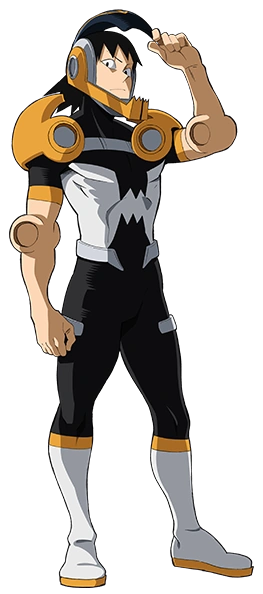

At the time of this writing, Gashly is likely slated to be Sero’s opponent. Can’t really get into too much specifics since I don’t know how that’ll play. So I’ll just give brief thoughts on why I think they’ll work, how I’d write Sero to make it evern more appropriate, and what Gashly deal might be.
Sero is the laidback, witty guy of the Class A who provides support and levity to his allies. In contrast, I imagine Gashly to be the type that only wants levity for himself in the form of his crimes: making twisted stories that involve brutal deaths of kids. If I were to write Sero’s arc, I’d probably make his jokey side both his reason to be a Hero and a bit of a front for insecurities of people taking ‘the guy who shoots tape’ seriously (especially after Shoto beats him in the Sports Festival). His victory against Gashly is him proving to the Villain and himself that it’s far more of a threat than people give it credit for.
For the Top Ten that beat Gashly before, I want to imagine Ryukyu did the deed. A fantasy creature Hero beating a storyteller is just fitting.
"Fang"/2nd Hired Gun - Ojiro
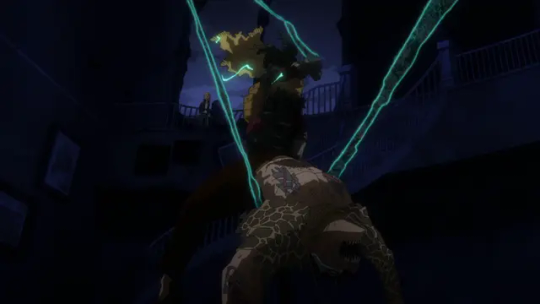

Yep, its Ojiro against the second Tartarus Jailbreaker AFO sent after Deku…who got his ass beat so very quickly. Name and power? Nope - just a reminder that Deku is so OP now not many can compare, because that certainly helps brings out the threat of even escaped criminals. Distaste aside, Fang (for lack of a better name) was chosen because, design wise, I feel a gangster type contrasts well against Ojiro being a disciplined martial artist.
Ojiro always had to face people criticizing for fighting ‘plainly’ with his Tail Quirk, and his own arc here could be accepting that, yeah, while not as flashy, as his peers, his Tail is more versatile in its simplicity and incredibly effective. Fang, as a dark reflection, could be what could have happened if Ojiro had a ‘flashier’ Quirk and let the fame of it go to his head. Since he’s a Tartarus Jailbreaker, and had quite a bit of jewelry on him, I’m going to give him something like a Metal Absorption Quirk. Something that, in theory, could pose a problem to Deku (if Fang didn’t get his ass beat so quickly). Whatever metallic substance he touches, his skin reflects it. In this case, befitting his chain around his neck, he skin becomes gold. I like to imagine Fang was originally overconfident and based too much of his pride in his Quirk. So much so that he was a bully that turned to a life of crime as head of his own crime gang. A gang that I imagined was stopped by one of the Top Ten heroes like Edgeshot.
Fang’s downfall, assumign he made it to the Final War, could be that arrogance biting him in the ass. He’s so cocky he fails to realize that, while Ojiro can’t necessarily hurt physically due to his Quirk, he can still use his tail to take him out by other means. Such as restraining Fang and knocking him out by suffocating him with his tail. Is Ojiro’s Quirk flashy as the others? No way, but he doesn’t need for it to be flashy to be effective. He just needs a chance to make that ‘plainess’ work extremely well for him. Leading for Fang to once again be defeated by someone both more humble and creative than him.
Dictator - Hagakure


It’s everyones least favorite clown villain - Dictator! But now he gets to face off against our perky spy!
So what would Hagakure’s storyline be for this? Before Sato and Ojiro's dealt with issues of the world such as feeling of being Outclassed or Plainness. So I figured an interesting contrast for Hagakure is to deal with personality and powers not really mixing. Her arc could be struggling to be an efficient espionage Hero when she longed to be in the spotlight, getting praises and such from the crowd like her friends If I were to rewrite the story, Hagakure's personality would be tweaked to be more of a cocky type, inspired by her bout of overconfidence during her 1B battle.
Early on she'd be extremely boastul & playful concerning her invisibility, blinding her enemies and taunting them throughout her fights...up until people eventually wisened up either by paying close attention to her voice, laying traps to trip up Hagakure or just using AOE moves if they had it. I could see another change could be that she might volunteer to go after Mustard in the Training Camp attack but ended up losing because she overestimated her own ability and her cockiness gave him an opening to knock out her out. Following that, her training under Yoroi Musha could be to grant herself more discipline and find different ways to channel her mischeviousness into being a better spy - one that can get a victory worth celebrating for and cheers at that!
So how would this relate to Dictator? Well, given his Despot Quirk and clown theming, I’d expand on this short guy as him being a ringmaster that wanted to put on the best show in Japan…problem is that he forcibly recruited/enslaved those he saw potential in his ‘circus’ via his Quirk. He’d trained them to Hell and back under very dangerous performances, up until an investigation was enacted. Something that lead to him taking over everyone, cops who came to arrest him and panicking audience, until Crust defeated him. In short he’s a tiny fella that wants to be in absolute full control from start to finish.
A control freak to the core against someone whose a master of surprise, it works out surprisingly well. For their fight, and to show how Hagakure’s grown, she’d silently wallop Dictator who’d be in utter panic over getting hit by seemingly no one. Enough that he loses his grip on Despot and release his prisoners by accident. Thus, giving Hagakure enough time to blind him before knocking him out with an uppercut…and celebrating with an appreciative audience for good measure.
"Neptune"/Hired Gun No# 3 - Shoji
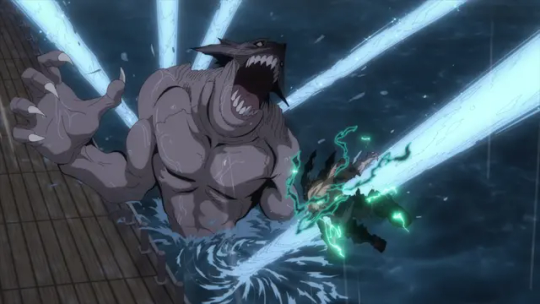
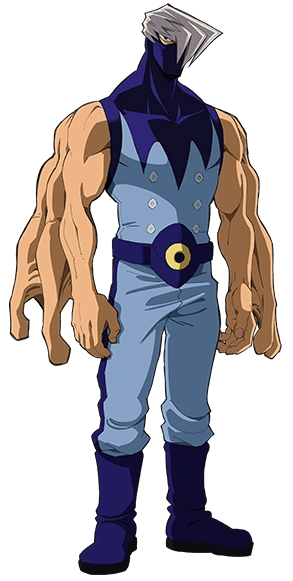
Finally, Shoji would have Neptune, for lack of a better name, as his Rival for the War fight. Now, why? Especially given that Shoji was meant to reflect Spinner. Now, on this end, I have said I disliked their pairing and I think that reason has to do with importance at the end of the day. Storywise, meaning. On Spinner's end, on the Villains side, he's had load of character development from his beginning as our lovable Stain cosplayer, to reluctant leader just trying to help out the one who cares about most. It's actually a remarkably clear and steady growth that leads up to his role in the Final War...
Yet, his Rival in this instance is Shoji. While Shoji's whole arc did have a few crumbs (such as his Pony fight), let's be honest he hasn't had any near enough importance or build-up in the story that really feels earned to be Spinner's Rival, nor do I feel that, given both of their roles in their respective groups, do I think they made even a natural match. Neptune here is meant to be a substitute for him that gives him a climatic finish and Spinner someone different to butt heads with (and will it be Tsu still?! Who knows!!!!)
Neptune here would be a mutant rights activist, though was dubbed a Villain after his protests involved taking a violent stance against those that harmed him and his shipping crew. In his case, I imagine Gang Orca was the one to defeat him, and given Gang Orca’s whole deal with being considered one of the scariest Heroes, Neptune might consider this a betrayal from someone in the same boat.
His role in the Final War arc would be assisting in the freedom of Kurogiri, and intercepting Shoji. Neptune would be the stance of physical rebellion - that change can not occur unless those affected fight back physically and showing their discontentment. Shoji would represent emotional rebellion - that change can not occur unless you show others by your character that you are different. Both aren’t really wrong in their ideals or their feelings on the matter, but it's Shoji that recognizes that working under All For One, someone who has no one but his own interests in heart, is not going to give the Heteromorphs the better treatment that they yearn for.
For Shoji's character arc in particular, I would change things so that the Heteromorph discrimination would be more out in the open in UA, likely in a history class that covers the great Jeda purge or 6/6 incident, and him being a bit more vocal concerning the reputation of mutants. Have it be a case where the class, naturally, is disgusted by such genocide, but seemingly think that its just a case of evil in a bygone era…up until its Shoji who ends up doing a report on just how many Heteromorphs make up the majority of the arrests in Japan kind and victim reports out in the slums, boonies and even the case of the cities they thought were safe from such prejudice. He isn’t condemning them for not knowing, but it is his words that get them to consider how they’ve been acting towards those who were like Shoji so far (like Shoto and how he treated the police chief). Just something to help boost the plotline a bit more.
I also think Neptune just fits with Shoji given their sea animal/monster theme, too. As for their fight, I imagine it’d go similar to Spinner fighting against Shoji, although in this case, I imagine Neptune’s need for water might eventually make him lose a battle of attrition against Shoji in the end. Though compared to Dictator or Fang, he’d be a Nemesis that Shoji does actually succeed in getting him to stand down and possibly even get rehabilitated for the future.
-
But, yeah, this has been the first part of the series, so far. Hope its been at least an interesting read through, and these match-ups make sense from your views.
I was very conflicted when it came to giving these guys Nemesis since they didn't really fit/other people in the Class were more fitting to get the likes of the League or MLA guys. I originally was going to pair the likes of Sato, Ojiro, Hagakure and Shoji with the High End Nomu, but a combo of the realism concerning them facing one, and just feeling iffy on them had me scrap the idea and put up the Nomu rule in effect. I wanted the Villain they face to not really be a monster like a Nomu.
I also did toy around with the movie stuff, namely the Heroes Rising Villains coming into play, though it would have been just Shoji, Hagakure, and Ojiro going against Chimera, Mummy and Slice, but figured it'd be best to stick to just the manga.
If you're wondering about Slidin Go', he's like the only exception to the Advisors showing up here due to being a thing before the group. He also was supposed to be who remained of Sato, Ojiro or even Sero as like a filler choice if I couldn't find a suitable villain. Sato happened to get the short end of the stick. SG is also here because still writing about the MLA guys, who are next, and had his completed first.
I actually had Hagakure locked into facing Mustard, but once it hit me to use the Jailbreakers, thought it'd be best for Mustard to face someone with more story importance and who could be a better contrast too. Aoyama was considered to but it felt awkward for me.
Here's hoping the next part comes out soon...or at least this year!
#my hero academia#mha#mha villains#league of villains#paranormal liberation front#meta liberation army#slidin' go#mha kunieda#mha gashly#mha jailbreakers#mha dictator#lov#plf advisers#mezo shoji#rikido sato#ojiro mashirao#toru hagakure#sero hanta#yuga aoyama#class 1a
23 notes
·
View notes
Text
Oh yeah, oh yeah one more thing before I fully fall asleep. Group chat thingy I made between Skeptic and the others❤️
(Sorry for a million tags)
#bnha#mha#my hero academia#boku no hero academia#meta liberation army#paranormal liberation front#plf#mla#tomoyasu chikazoku#skeptic bnha#redestro#curious bnha#bnha geten#lov#league of villains#shigaraki#dabi#bnha twice#mr compress#bnha spinner#trumpet bnha#koku hanabata
374 notes
·
View notes
Text
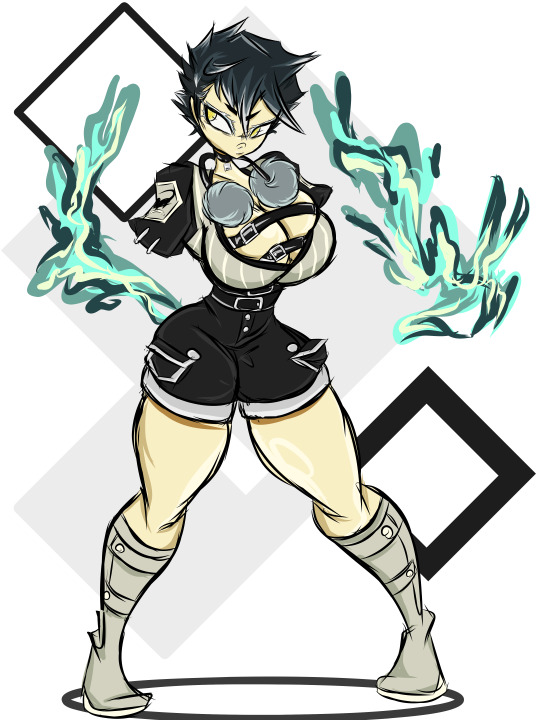
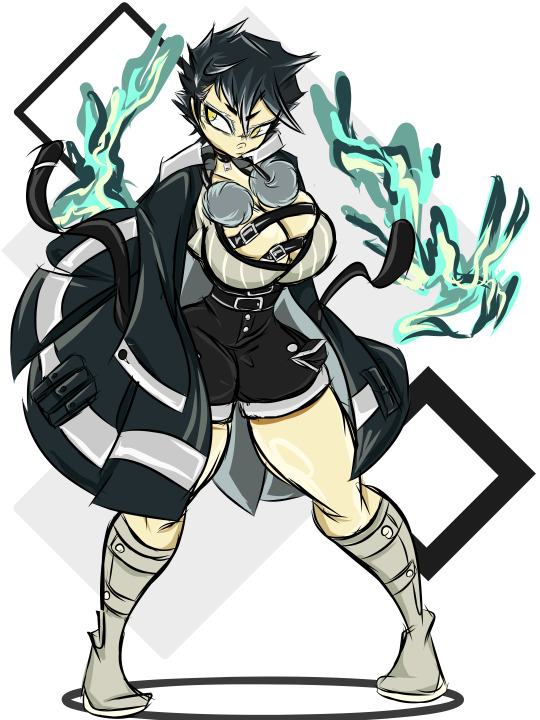
BNHA OC- Xiezhi Update
Just a newer doodle of her since I haven't really anything My Hero in ages.
Hat Alts:
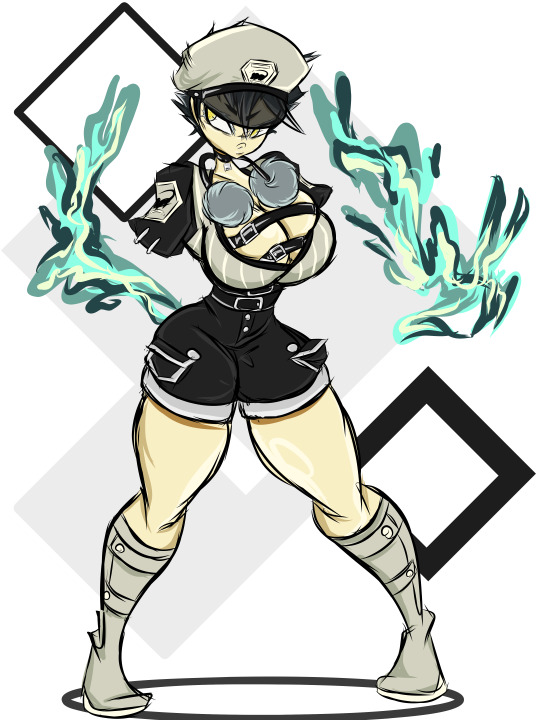

#oc#character design#bnha#mha#boku no hero academia#my hero academia#mla#meta liberation army#xieye biaoda#xiezhi#anime
24 notes
·
View notes